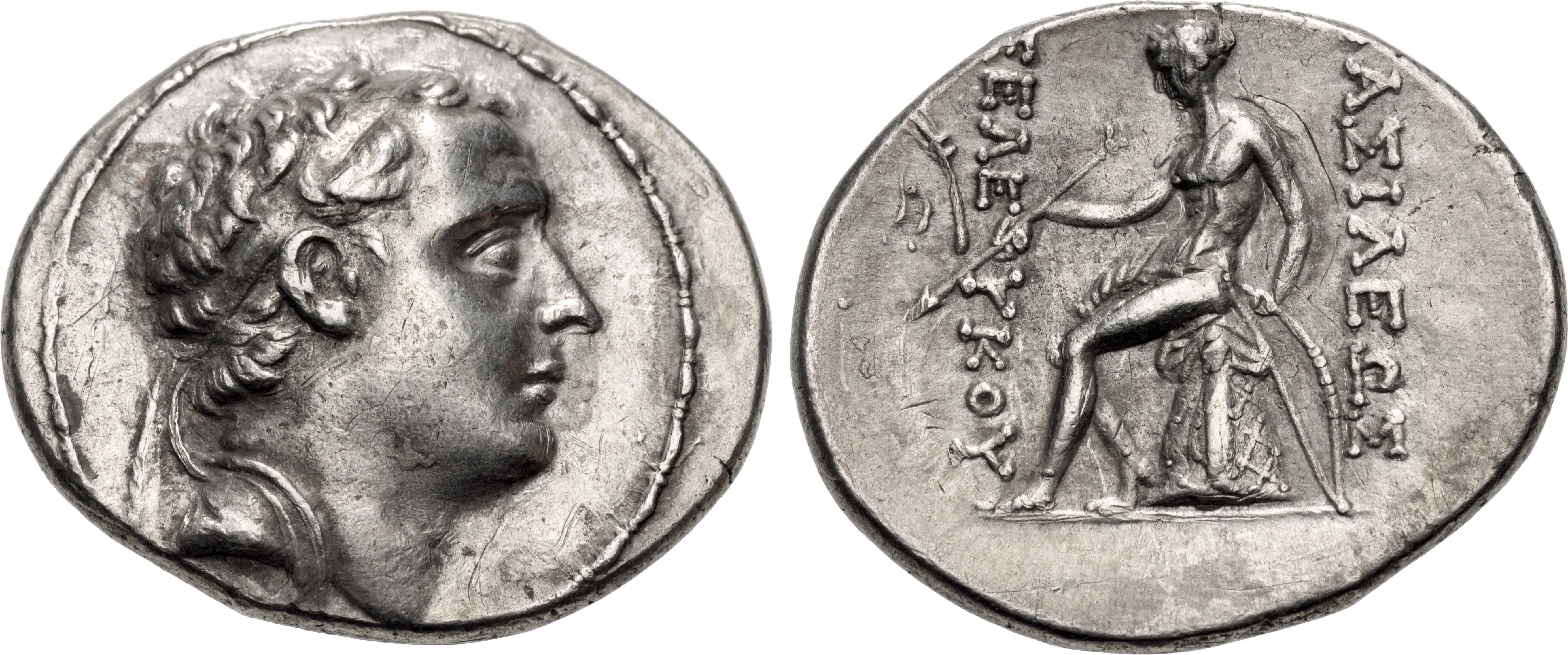Antioch (Seleucus IV), silver, tetradrachms (187-175 BCE)
From SILVER
187 BCE - 175 BCE Silver 8,330 kg
Description
| ObverseInscription or printing placed on the obverse.: | Diademed head right |
| ReverseInscription or printing placed on the reverse.: | ΒΑΣΙΛΕΩΣ ΣΕΛΕΥΚΟΥ (Greek).Apollo, testing arrow and placing hand on grounded bow, seated left on omphalos, filleted palm frond to outer left |
Mint and issuing power
| MintIdentifies the place of manufacture or issue of a numismatic object.: | Antioch | Ancient regionAncient region.: | Syria | Modern countryModern country: Turkey | AuthorityIdentifies the issuing power. The authority can be "pretended" when the name or the portrait of X is on the coin but he/she was not the issuing power. It can also be "uncertain" when there is no mention of X on the coin but he/she was the issuing power according to the historical sources: | Seleucid Dynasty (312-63 BC), Seleucus IV Philopator (Seleucid king, 187-175 BC) |
Chronology
| FromIdentifies the initial date in a range assigned in a numismatic context. | 187 BCE | toIdentifies the final date in a range assigned in a numismatic context.. | 175 BCE | PeriodTime period of the numismatic object.: Hellenistic 323-30 BC |
Physical description
| MetalThe physical material (usually metal) from which an object is made.: | Silver |
Median weightMedian of the weights of numismatic objects (in grams). in grams | 17.00 | DenominationTerm indicating the value of a numismatic object. Examples: tetradrachm, chalkous, denarius.: | tetradrachm |
StandardStandard.: | Attic |
Image

H281 Antioch Seleucus IV.jpg [1]
References
| Die study referencePublication of the study: | Houghton 19911Houghton 1991, p. 82-83 (Table 3), Le Rider 19932Le Rider 1993, p. 49-67, pl. 14-16 | ||
| Coin series referenceReference to coin series study: | Sear II3Sear II, n° 6966, RQEMH4RQEMH, n° 281, SC II5SC II, n° 1313, HGC 96HGC 9, n° 580-582 | ||
Obverse dies distribution
| FrequencyFrequency of specimen in distribution. ᵖ | Number of obversesNumber of obverse dies. ᵖ (o) | % (o) | Number of coinsNumber of coins. (n) | % (n) | Die nameName(s) of the die(s). |
| 1 | 3 | 13.04 | 3 | 2.01 | 11, 18, 22 |
| 2 | 4 | 17.39 | 8 | 5.37 | 12, 13, 17, 23 |
| 3 | 1 | 4.35 | 3 | 2.01 | 3 |
| 4 | 3 | 13.04 | 12 | 8.05 | 5, 14, 20 |
| 5 | 3 | 13.04 | 15 | 10.07 | 7, 16, 21 |
| 7 | 2 | 8.7 | 14 | 9.4 | 9, 10 |
| 8 | 1 | 4.35 | 8 | 5.37 | 15 |
| 9 | 1 | 4.35 | 9 | 6.04 | 4 |
| 10 | 1 | 4.35 | 10 | 6.71 | 6 |
| 11 | 1 | 4.35 | 11 | 7.38 | 2 |
| 13 | 2 | 8.7 | 26 | 17.45 | 8, 19 |
| 30 | 1 | 4.35 | 30 | 20.13 | 1 |
| Total | 23 of 23 | 100.01 | 149 of 149 | 99.99 |
Reverse dies distribution
no distribution is available
Quantification
| Number of obversesNumber of obverse dies. ᵖ (o) | 23 | Number of singletons (o1)The number of singleton coins. ᵖ | 3 |
| Number of reverse diesNumber of reverse dies. (r) | 117 | Number of coinsNumber of coins. (n) | 149 |
| Coins per obverse dieNumber of coins per obverse die. (n/o) | 6.48 | Coins per reverse dieNumber of coins per reverse die. (n/r) | 1.27 |
| Reverse per obverse ratioRatio of obverse dies divided by reverse dies. (r/o) | 5.09 | Percentage of singletons (o1)number of coins (n) divided by the number of singletons (o1) ᵖ | 13.04 % |
| Original number of dies (O) (Carter 1983 formula)The estimation of the number of coins according to Carter 1983 ᵖ | 24.5 | Coins struck if 20,000 as average productivity per dieCoins made if the average productivity for obverses (according to Carter) is 20,000. ᵖ | 490,000 |
| Original number of dies (O) (Esty 2011 formula)The estimation of the number of coins according to the singleton formula in Esty 2011 ᵖ (O) | 27.2 | Survival rate if 20,000 as average productivity per dieSurvival rate if average productivity is 20,000. ᵖ | 0.00030 |
| Coverage (o = % of O) (Esty 1984 formula)Esty 1984 - coverage (% of O) ᵖ (o = % of O) | 97.99% | Die productivity if survival rate 1/2,000Average productivity if survival rate is 1/2,000. ᵖ | 12,163.27 |
| Weight of silver (in kg) if 20,000 coins per die (O = Carter formula)Carter 1983 * Median weight * 20000 (*10 if gold or electrum) ᵖ | 8,330 kg <br /> 8,330 kg | Die productivity if survival rate 1/5,000Average productivity if survival rate is 1/5,000. ᵖ | 30,408.16 |
Remarks
Most likely one single workstation Houghton 1991: 24 obverses for 124 coins